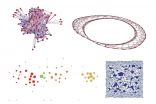(Press-News.org) The global spread of Ebola is due to the complex interactions between individuals, societies, and transportation and trade networks. Understanding and building appropriate statistical and mathematical models of these interactions is vital to responding to the challenges of living in a networked world. There are, of course, many other examples of complex networks -- from national power grids and airline networks to social networks, neuronal networks and protein-protein interactions.
In a new study published in the Beijing-headquartered journal National Science Review, scientists based in China and Australia state that in complex systems, to understand the behavior of the system it is becoming necessary first to properly chart the structure of the network.
In an article titled "Random complex networks," Michael Small, based at The University of Western Australia, Lvlin Hou, based at China's National University of Defense Technology, and Linjun Zhang, a PhD candidate at University of Pennsylvania, note that in physics and mathematics, one typically characterizes the structure of complex networks by looking at the connections between individual components, and creating a distribution - the node degree distribution - characterizing the expected number of connections for a random component.
In some systems, they add, individual components have a similar number of neighbors - most traffic intersections are junctions of two, three or four roads. In other systems the numbers vary wildly - some websites have only a few links pointing at them; others have many tens of thousands. Most proteins interact with only one or two others; some form thousands of interactions. Most people have a few friends (or colleagues, or contacts); some have many more. Systems exhibiting this wildly varying degree of connectivity are an extreme challenge for mathematicians and physicists to describe: what does one mean by choosing one of these systems at random? How should those connections be configured?
Co-authors of the paper "Random Complex networks" seek to answer these questions.
Several models have already been proposed to generate networks of interacting individuals with wildly varying connectivity. The most famous of these is known as preferential attachment and follows the social maxim of "the rich get richer". As time progresses, the individuals in the network with the most connections are the ones most likely to acquire new connections. Just as in the real world, wealth attracts still more wealth and societies develop with most people having little and a small minority having most of the resources.
While this is intuitive, it turns out that there is a much richer and more interesting structure of complex networks that is not explored with this approach. Co-authors of the National Science Review paper provide a solution by proposing a simple method to fully explore the mathematical space of all "interesting" networks with a particular node degree distribution. They achieve this aim by randomly exchanging edges on the network.
This simple process (justified with some less simple mathematics) allows scientists to explore the behavior of typical networks. This process can be applied to experimentally obtained networks (from airline transportation networks, to gene interaction, Internet, social connections and so on) to probe which features of the individual networks are the really important defining structures.
While the preferential attachment model is a common approach to construct such networks, the co-authors of the new study show for the first time that features of this model are not typical. In particular, preferential attachment networks are "robust-yet-fragile". That is, by random deleting parts of the network, the overall network structure is largely unaffected (the robustness part). However, deliberately attacking particular nodes in the network can quickly lead to complete collapse (fragility).
It was thought that this is a common property of all networks with such wildly divergent degrees of connection. However, there is mounting evidence that many systems do not have this property. The new study shows that most typical networks are robust to both random and deliberate attacks. This result provides a better explanation of earlier observations of many natural and technological complex systems.
INFORMATION:
See the article:
Michael Small, Lvlin Hou, and Linjun Zhang
Random complex networks
National Science Review, 2014, 1(3): 357-367
http://nsr.oxfordjournals.org/content/1/3/357.full
The National Science Review is the first comprehensive scholarly journal released in English in China that is aimed at linking the country's rapidly advancing community of scientists with the global frontiers of science and technology. The journal also aims to shine a worldwide spotlight on scientific research advances across China.
This news release is available in Japanese.
New research published in the Proceedings of The Royal Society A by members of the Mathematical Soft Matter Unit at the Okinawa Institute of Science and Technology Graduate University examines the energies at work in a closed flexible loop spanned by a soap film. While the underlying experiments are simple enough to be replicated in a kitchen sink, the research generates potentially important questions and changes how we think about different disciplines from material science to vertebrate morphogenesis. Aisa Biria and Professor ...
UNIVERSITY OF CALIFORNIA, BERKELEY'S HAAS SCHOOL OF BUSINESS -Too many vehicles on the highway inevitably slow down traffic. On the Internet information highway, consumers value high-speed Internet service, but there is little reason to think broadband traffic congestion will improve if the Federal Communications Commission abandons net neutrality, according to economic research.
In their paper, "The Economics of Network Neutrality," Ben Hermalin, Haas Economics Analysis and Policy Group, and Nicholas Economides, Berkeley-Haas visiting professor from NYU'S Stern School ...
Scientists at the University of Strathclyde and City University of New York have created methods that dramatically simplify the discovery of biological gels for food, cosmetics and biomedicine, as published in the journal Nature Chemistry.
Strathclyde's Dr Tell Tuttle and Professor Rein Ulijn, the director of nanoscience at City University New York's new advanced research centre who also holds a position at Strathclyde, believe their team's breakthrough dramatically simplifies discovery of functional gels that can be used in a wide range of applications.
Until now, ...
The drug daclatasvir (trade name Daklinza) has been available since August 2014 for the treatment of adults with chronic hepatitis C (CHC) infection. The German Institute for Quality and Efficiency in Health Care (IQWiG) examined in a dossier assessment whether this new drug offers an added benefit over the appropriate comparator therapy.
The drug manufacturer presented data for patients without cirrhosis of the liver who are infected with hepatitis C virus (HCV) genotype 1, and for patients with HCV genotype 4. However, these data are unsuitable in various aspects to ...
Pioneering new research by the University of Exeter could revolutionise global diagnostic procedures for one of the most common forms of epilepsy.
Scientists from Exeter have investigated using mathematical modelling to assess susceptibility to idiopathic generalised epilepsy (IGE) by analysing electrical activity of the brain while the patient is in a resting state.
Current diagnosis practices typically observe electrical activities associated with seizures in a clinical environment.
The ground-breaking research has revealed differences in the way that distant regions ...
"A tree must be bent while it is young," as one saying about learning a foreign language goes. In other words, the earlier you start learning a foreign language systematically, the better the language level will be in the long run. The second widely held view is that you need to be solid in your first language (L1) in order to develop good literacy skills in the foreign language. Linguist Simone Pfenninger from the University of Zurich has been examining these two myths in her five-year study involving Swiss high-school children in order to identify the optimal starting ...
Reston, Va. (December 9, 2014) - Cancer therapy can be much more effective using a new way to customize nuclear medicine treatment, researchers say in the December 2014 issue of The Journal of Nuclear Medicine. The process could also be useful for other diseases that could benefit from targeted radiation.
Targeted therapy with radiopharmaceuticals--radioactive compounds used in nuclear medicine for diagnosis or treatment--has great potential for the treatment of cancer, especially for cancer cells that have migrated from primary tumors to lymph nodes and secondary organs ...
London, United Kingdom, December 9, 2014 - As the Ebola Virus Diseases (EVD) epidemic continues to rage in West Africa, infectious diseases experts call attention to the striking lack of treatment guidelines. With over 16,000 total cases and more than 500 new infections reported per week, and probable underreporting of both cases and fatalities, the medical community still does not have specific approved treatment in place for Ebola, according to an editorial published in the International Journal of Infectious Diseases.
Not only are treatment guidelines lacking, but ...
Studying the social interaction of bears through the use of camera traps and visual observations requires that humans be able to tell individuals apart. A study done using volunteers to study the vulnerable Andean bear indicates that people can learn to identify individual bears, given a little practice. The research, done by San Diego Zoo conservationists with international collaborators using photos spanning many years, also indicates that young bears usually retain many of their unique markings as they grow older.
"Knowing, scientifically, that people who have been ...
Researchers from Johannes Gutenberg University Mainz (JGU) and the Julius Maximilian University of Würzburg are proposing potential new active substances for treating the dengue virus. Just like Ebola, dengue fever is also caused by a virus for which there is currently no cure and no vaccine and can be fatal.
In the quest for medication to treat the dengue virus, the scientific community is focusing on a particular enzyme of the pathogen, the protease known as NS2B/NS3. The reason for this is that inhibitors of similar proteases have been revealed to be very effective ...


